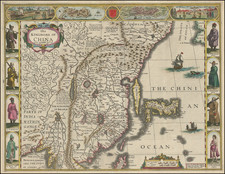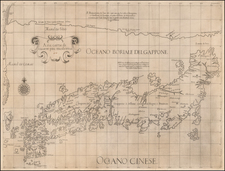Commodore Perry's Fleet Arrives in Edo Bay.
A large double-page two-sheet kawaraban with a fold along the left edge. The upper section of this image is a list of the officials responsible for coastal defense. The lower right side shows an American paddle steamer with a figure of an American man with a gun. The text to the right of the ship says: "Under the order of the President of the United States of North America a Commodore called Perry, leading the fleet, came to Uraga."
The lower left side of the kawaraban is a map showing the American fleet at anchor, while along the coastline it indicates the names of the Japanese officials assigned to coastal defense duty.
The Perry Expedition was a diplomatic and military undertaking to Japan during its Bakumatsu period. The Expedition involved two separate trips of steamships of the United States Navy, which took place during 1852-1854. The goals of the expedition included exploration, surveying, the establishment of diplomatic relations, and the "opening" of Japan to trade with the United States. The Perry Expedition had a colossal influence on 19th century Japan, leading to interaction with, and influence by, the outside world, the collapse of the Tokugawa shogunate and the Meiji Restoration. In the Western world, the opening of Japan to trade led to a period of Japonisme in decorative and fine arts and culture.
Japanese newspapers began in the 17th century as yomiuri (読売、literally "to read and sell") or kawaraban (瓦版, literally "tile-block printing" referring to the use of clay printing blocks), which were printed handbills sold in major cities to commemorate major social gatherings or events. These sheets were often printed anonymously.
The kawaraban publishers served as a crucial vector for the transmission of information about Commodore Mathew Perry's opening of Japan. During the Edo Period, the arriving European vessels were called kurofune (Black Ships). That time was characterized by great social upheaval, and intense public interest in the agents of the outside world arriving in Japan.
Anna Wada, in "About Kawaraban", Perry in Japan A Visual History, gives background on the kawaraban:
The kawaraban took up a range of topics, including natural disasters, superstitious happenings, murders, and less commonly, political satire. Printers chose topics more to entertain and satisfy the readers’ curiosity than to educate them. Visual components such as illustrations, diagrams, and maps attracted the people to the print and helped them to understand the text, as well as sometimes offering additional information.
Throughout the Edo period the shogunate repeatedly restricted printing for a mass audience, particularly seeking to avoid rumors and political commentary. By the time the Black Ships [i.e., Perry’s fleet] arrived at the end of the Edo period, however, the system of censorship could not keep up with the number of prints in circulation. The increase in publications coincided with the spread of literacy in both urban and rural areas.










![[ Japan ] Royaume du Iapon. Designe par le Pere Ph. Briet de la Compagnie de Iesus . . .](https://storage.googleapis.com/raremaps/img/small/75238.jpg)


![(Second World War - Bombing of Japan) Tachiarai AF RESTRICTED [Three Reconnaissance Photos of Tachiarai Air Force Base]](https://storage.googleapis.com/raremaps/img/small/90451.jpg)
![[Whaling Operations] Pesca della Balena | Pesca del Pesce Sega](https://storage.googleapis.com/raremaps/img/small/78472.jpg)